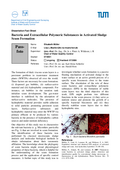Dr. rer. nat. Elisabeth Müller

Raum: | 1131 |
Telefon: | +49.89.289.13720 |
Telefax: | +49.89.289.13718 |
E-Mail: | e.mueller(at)tum.de |
Arbeitsgruppe: | Mikrobiologische Systeme |
Lebenslauf
| seit 2010 | Leiterin des biologischen Labors und der Arbeitsgruppe „Mikrobiologische Systeme“ am Lehrstuhl für Siedlungswasserwirtschaft der TU München, Prof. H. Horn/ Prof. B. Helmreich/Prof. J. Drewes |
| 2007-2009 | Post-Doc am Lehrstuhl für Siedlungswasserwirtschaft der TU München, Prof. H. Horn |
| 2006 | Promotion (Dr. rer. nat.), TU München |
| 2005-2007 | Mutterschutz und Elternzeit |
| 2002 | Auslandsaufenthalt: Advanced Water Management Center, University of Queensland, Brisbane, Australien, Prof J. Keller, Prof. L.L. Blackall |
| 2001-2004 | Wissenschaftliche Mitarbeiterin am Lehrstuhl für Siedlungswasserwirtschaft, TU München, Prof. P. Wilderer |
| 1997-2001 | Wissenschaftliche Angestellte (Teilzeit) am Bayerischen Landesamt für Wasserwirtschaft, Referat Mikrobiologie, Dr. H. Lemmer |
| 1997-2001 | Wissenschaftliche Mitarbeiterin (Teilzeit) am Lehrstuhl für Wassergüte und Abfallwirtschaft, TU München, Prof. P. Wilderer |
| 1995-1997 | Wissenschaftliche Mitarbeiterin am GSF-Forschungszentrum für Umwelt und Gesundheit GmbH, Institut für Bodenökologie, Arbeitsgruppe Molekulare Mikrobenökologie, PD Dr. A. Hartmann |
| 1994 | Abschlusszeugnis, TU München |
| 1993-1994 | Aufbaustudium Umweltschutztechnik, TU München |
| 1993 | Diplom (Dipl.-Biol. Univ), LMU München |
| 1986-1993 | Studium der Biologie an der LMU-München |
Lehre
- Grundlagen Ökologie
- Betreuung von Bachelor- und Masterarbeiten
- Doktorandenseminar
Forschungsgebiete
- Mikrobielle Abwasser- und Umweltbiozönosen
- Xenobiotika abbauende mikrobielle Biozönosen, fäkale Indikatororganismen
- Verbleib und biologischer Abbau von Xenobiotika
- Mikrobiell induzierte Korrosion
Buchbeiträge
- Müller, E., Aßmus, B., Hartmann, A., Seiler, K.-P., 1998. In situ-Nachweis der mikrobiellen Biofilmgemeinschaft in einem Grundwasserhabitat- Erfolge und Probleme, in: Wasserwirtschaft, B.L.f. (Ed.), Neueste Entwicklungen in der in situ-Charakterisierung mikrobieller Biozönosen in Abwasser, Oberflächengewässern, Grund- und Trinkwasser. Oldenbourg Verlag, München, pp. 145-162.
- Drewello, U., Rölleke, S., Müller, E., Wuertz, S., Weißmann, R., 2000. Ergebnisse zum Abtrag von Biofilmen, in: Römich, H. (Ed.), Reinigung von historischen Glasmalereien mit Lasertechnik. Fraunhofer IRB Verlag, Stuttgart, pp. 74-125.
- Müller, E., Aßmus, B., Hartmann, A., Seiler, K.-P., 2000. The in situ detection of microbial biofilm community on karst rock coupon in a groundwater habitat, in: Flemming, H.-C., Szewzyk, U., Griebe, T. (Eds.), Biofilms Investigative methods & applications. Technomic Publishers, Lancaster, PA, USA, pp. 155-163.
- Müller, E., Wuertz, S., 2000. Prozesskontrolle mit Fluoreszenzmessungen, in: Römich, H. (Ed.), Reinigung von historischen Glasmalereien mit Lasertechnik. Fraunhofer IRB Verlag, Stuttgart, pp. 180-198.
- Kragelund, C., Müller, E., Schade, M., Nguyen, H.T.T., Lemmer, H., Seviour, R., Nielsen, P.H., 2009. Identification of filamentous bacteria by FISH, in: Nielsen, P.H., Daims, H., Lemmer, H. (Eds.), FISH handbook for biological wastewater treatment: identification and quantification of microorganisms in activated sludge and biofilms by FISH. IWA Publishing, London, pp. 33-67.
Publikationen (peer-reviewed)
- Drewello, U., Weißmann, R., Rölleke, S., Müller, E., Wuertz, S., Fekrsanati, F., Troll, C., Drewello, R., 2000. Biogenic surface layers on historical window glass and the effect of excimer laser cleaning. J. Cult. Herit. 1, S161-S171.
- Lemmer, H., Lind, G., Müller, E., Schade, M., Ziegelmayer, B., 2000. Scum in activated sludge plants: impact of non-filamentous and filamentous bacteria. Acta Hydroch. Hydrob. 28, 34-40.
- Wuertz, S., Müller, E., Spaeth, R., Pfleiderer, P., Fleming, H.-C., 2000. Detection of heavy metals in bacterial biofilms and microbial flocs with the fluorescent complexing agent Newport Green. J. Ind. Microbiol. Biotechnol. 24, 116-123.
- Falkentoft, C.M., Arnz, P., Henze, M., Mosbaek, H., Müller, E., Wilderer, P.A., Harremoes, P., 2001. Possible complication regarding phosphorus removal with a continuous flow biofilm system: diffusion limitation. Biotechnol. Bioeng. 76, 77-85.
- Müller, E., Drewello, U., Drewello, R., Weißmann, R., Wuertz, S., 2001. In situ analysis of biofilms on historic window glass using confocal laser scanning microscopy. J. Cult. Herit. 2, 31-42.
- Falkentoft, C., Müller, E., Arnz, P., Harremoes, P., Mosbaek, H., Wilderer, P., Wuertz, S., 2002. Population changes in a biofilm reactor for phosphorus removal as evidenced by the use of FISH. Water Res. 36, 491-500.
- Lemmer, H., Müller, E., Schade, M., 2002. Scum in nutrient removal plants: The role of carbon sources in "Microthrix parvicella" growth. Acta Hydroch. Hydrob. 30, 207-211.
- Müller, E., Kriebitzsch, K., Wilderer, P., Wuertz, S., 2002a. Community structure of micro- and macroflocs in pin-point sludge and the influence of sludge age and potassium addition on microfloc formation. Water Sci. Technol. 46, 405-412.
- Römich, H., Dickmann, K., Mottner, P., Hildenhagen, J., Müller, E., 2003. Laser cleaning of stained glass windows – Final results of a research project. J. Cult. Herit. 4, 112-117.
- Lemmer, H., Lind, G., Müller, E., Schade, M., 2005. Non-famous scum bacteria: biological characterization and troubleshooting. Acta Hydroch. Hydrob. 33, 197-2002.
- Müller, E., Lind, G., Lemmer, H., Wilderer, P.A., 2005. Population structure and chemical EPS analyses of activated sludge and scum. Acta Hydroch. Hydrob. 33, 189-196.
- Müller, E., Schade, M., Lemmer, H., 2007. Filamentous scum bacteria in activated sludge plants: detection and identification quality by conventional sludge microscopy vs. fluorescence in situ hybridization. Water Environ. Res. 79, 2274-2286.
- Kieu, H.T.Q., Müller, E., Horn, H., 2011. Heavy metal removal in anaerobic semi-continuous stirred tank reactors by a consortium of sulfate-reducing bacteria. Water Res. 45, 3863-3870.
- Liu, S.T., Horn, H., Müller, E., 2013. A systematic insight into a single-stage deammonification process operated in granular sludge reactor with high-loaded reject-water: characterization and quantification of microbiological community. J. Appl. Microbiol. 114, 339-351.
- Gilbert, E., Müller, E., Horn, H., Lackner, S., (2013). Microbial activity of suspended biomass from a nitritation–anammox SBR in dependence of operational condition and size fraction-anammox SBR. Appl. Microbiol. Biot. 2012 Dec 5;: 23212673.
- Müller, E., Schüssler, W., Horn, H., Lemmer, H., (2013). Aerobic biodegradation of the sulfonamide antibiotic sulfamethoxazole by activated sludge applied as co-substrate and sole carbon and nitrogen source. Chemosphere DOI 10.1016/j.chemosphere.2013.02.070.
Tagungsbeiträge
- Müller, E., Hartmann, A., Seiler, K.-P., 1999. Mikrobiologische Aktivitäten und Umsetzung im Karst der südlichen Frankenalb, in: Seiler, K.-P. (Ed.), Grundwasserschutz im Karst. GSF - Forschungszentrum für Umwelt und Gesundheit, GmbH, München, Neuherberg.
- Müller, E., Lind, G., Lemmer, H., 2001. Comparative bacteria community analysis of municipal and industrial activated sludge and scum: FISH VS. classical findings, in: Tandoi, V. (Ed.), ASPD3, Microorganisms in activated sludge and biolfilm process III. IWA, Rom, Italy.
- Hausner, M., Bathe, S., Lebuhn, M., Müller, E., Raizada, N., Wilderer, P.A., 2003. How can engineers profit from the application of modern microscopic and molecular biology techniques to wastewater and waste treatment?, in: Wanner, J., Sykora, V. (Eds.), Wastewater 2003, 5th International Biennial Conference and Exhibition of the Association of Wastewater Treatment Experts of the Czech Republic, Olomouc, Czech Republic, May 13-15, 2003 (ISBN 80-239-0573-2).
- Müller, E., Schade, M., Lemmer, H., 2005. Filamentous scum bacteria in activated sludge plants: detection and identification quality by conventional sludge microscopy vs. fluorescence in situ hybridization, in: Hall, S.J., Blackhall, L.L. (Eds.), ASPD4, Activated sludge population dynamics. IWA, Brisbane, Australia.
- Lemmer, H., Müller, E., Schade, M., 2007. Blähschlamm und Schwimmschlamm – Problem erkannt, Problem gebannt! in: Günthert, F.W. (Ed.), Wirtschaftliches Handeln in Bayerischen Kommunen und Mikrobiologische Probleme bei Schlammseparation und Schlammbehandlung. Oldenbourg Industrieverlag GmbH, München, Neubiberg.
- Müller, E., Lemmer, H., 2007. Identifizierung von Fadenorganismen: klassische Mikroskopie oder Einsatz von Gensonden? in: Günthert, F.W. (Ed.), Wirtschaftliches Handeln in Bayerischen Kommunen und Mikrobiologische Probleme bei Schlammseparation und Schlammbehandlung. Oldenbourg Industrieverlag GmbH, München, Neubiberg.
- Müller, E., Arbeiter, A., Horn, H., Lemmer, H., 2009. Characterization of antibiotic sulfamethoxazole (SMX) degrading wastewater biocenoses., in: Nielsen, P.H. (Ed.), ASPD5, Microbial popualtion dynamics in biological wastewater treatment. IWA, Aalborg, Denmark.
- Li, C., Lackner, S., Müller, E., Schwingel, T., Applegate, C., Horn, H., 2011. Modeling the nitrogen removal efficiency of an integrated fixed-film activated sludge system (IFAS), IWA Biofilm Conference: Processes in Biofilms, Shangai, China.
- Walters, E., Müller, E., Hille, A., Horn, H., 2011. Method for tracking particulate COD in biofilms, IWA Biofilm Conference, Processes in Biofilms. IWA, Shangai, China.
- Herzog, B., Lemmer, H., Helmreich, B., Müller, E., 2012. Möglichkeiten des mikrobiologischen Abbaus von Benzotriazolverbindungen, in: Helmreich, B., Günthert, F.W. (Eds.), Weitergehende Abwasserreinigung – brauchen wir eine vierte Reinigungsstufe? 40. Abwassertechnisches Seminar (ATS), Garching.
- Walters, E., Kätzl, K., Müller, E., Horn, H., 2013. Srvival of fecal indicator bacteria in sediment of an oligotrophic river, 6th International Conference on Water Resources and Environment Research, Water and Environmental Dynamics, Koblenz, Germany.
- Herzog, B., Lemmer, H., Helmreich, B., Horn, H., Müller, E., 2013. Monitoring benzotriazoles in three wastewater treatment plants and removal via biodegradation within activated sludge communities, 96th Canadian Chemistry Conference and Exhibition, Quebec, Canada.
